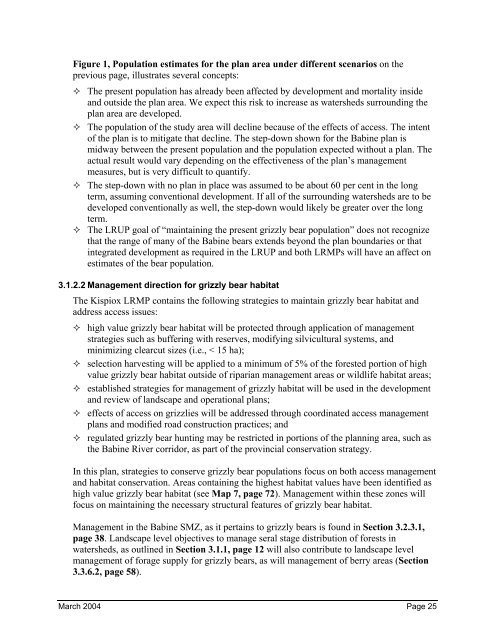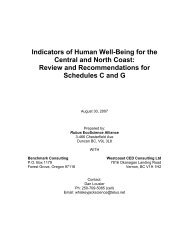West Babine Sustainable Resource Management Plan
West Babine Sustainable Resource Management Plan
West Babine Sustainable Resource Management Plan
You also want an ePaper? Increase the reach of your titles
YUMPU automatically turns print PDFs into web optimized ePapers that Google loves.
Figure 1, Population estimates for the plan area under different scenarios on the<br />
previous page, illustrates several concepts:<br />
The present population has already been affected by development and mortality inside<br />
and outside the plan area. We expect this risk to increase as watersheds surrounding the<br />
plan area are developed.<br />
The population of the study area will decline because of the effects of access. The intent<br />
of the plan is to mitigate that decline. The step-down shown for the <strong>Babine</strong> plan is<br />
midway between the present population and the population expected without a plan. The<br />
actual result would vary depending on the effectiveness of the plan’s management<br />
measures, but is very difficult to quantify.<br />
The step-down with no plan in place was assumed to be about 60 per cent in the long<br />
term, assuming conventional development. If all of the surrounding watersheds are to be<br />
developed conventionally as well, the step-down would likely be greater over the long<br />
term.<br />
The LRUP goal of “maintaining the present grizzly bear population” does not recognize<br />
that the range of many of the <strong>Babine</strong> bears extends beyond the plan boundaries or that<br />
integrated development as required in the LRUP and both LRMPs will have an affect on<br />
estimates of the bear population.<br />
3.1.2.2 <strong>Management</strong> direction for grizzly bear habitat<br />
The Kispiox LRMP contains the following strategies to maintain grizzly bear habitat and<br />
address access issues:<br />
high value grizzly bear habitat will be protected through application of management<br />
strategies such as buffering with reserves, modifying silvicultural systems, and<br />
minimizing clearcut sizes (i.e., < 15 ha);<br />
selection harvesting will be applied to a minimum of 5% of the forested portion of high<br />
value grizzly bear habitat outside of riparian management areas or wildlife habitat areas;<br />
established strategies for management of grizzly habitat will be used in the development<br />
and review of landscape and operational plans;<br />
effects of access on grizzlies will be addressed through coordinated access management<br />
plans and modified road construction practices; and<br />
regulated grizzly bear hunting may be restricted in portions of the planning area, such as<br />
the <strong>Babine</strong> River corridor, as part of the provincial conservation strategy.<br />
In this plan, strategies to conserve grizzly bear populations focus on both access management<br />
and habitat conservation. Areas containing the highest habitat values have been identified as<br />
high value grizzly bear habitat (see Map 7, page 72). <strong>Management</strong> within these zones will<br />
focus on maintaining the necessary structural features of grizzly bear habitat.<br />
<strong>Management</strong> in the <strong>Babine</strong> SMZ, as it pertains to grizzly bears is found in Section 3.2.3.1,<br />
page 38. Landscape level objectives to manage seral stage distribution of forests in<br />
watersheds, as outlined in Section 3.1.1, page 12 will also contribute to landscape level<br />
management of forage supply for grizzly bears, as will management of berry areas (Section<br />
3.3.6.2, page 58).<br />
March 2004 Page 25

















